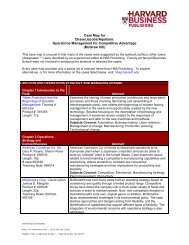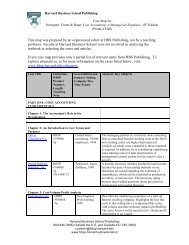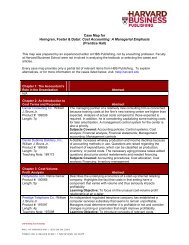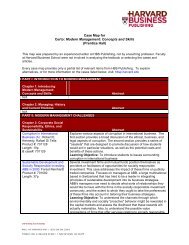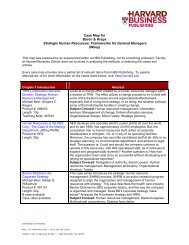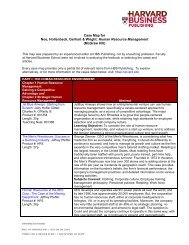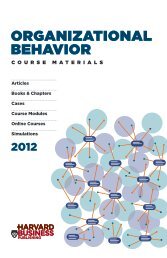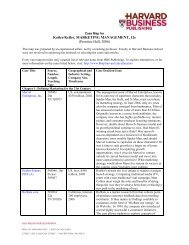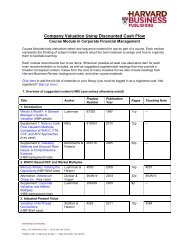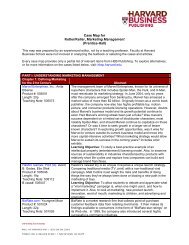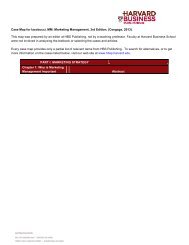teAcHing MATErIAlS - Harvard Business School Press
teAcHing MATErIAlS - Harvard Business School Press
teAcHing MATErIAlS - Harvard Business School Press
Create successful ePaper yourself
Turn your PDF publications into a flip-book with our unique Google optimized e-Paper software.
SALES — SERVICE MANAGEMENT — SOCIAL ENTERPRISE<br />
rethink performance management, open new<br />
channels between sales and marketing, and<br />
invest in talent development.<br />
Teaching Sales<br />
Suzanne Fogel, David hoffmeister,<br />
Richard Rocco, Daniel P. Strunk<br />
<strong>Harvard</strong> <strong>Business</strong> Review Case<br />
Product #R1207H (7 pages)<br />
A well-staffed sales function is vital to business<br />
success, but most MBA programs fail<br />
to offer any sales-related courses at all. As<br />
selling becomes more sophisticated and solutions-oriented<br />
and good sales jobs go unfilled<br />
for lack of qualified applicants, the value of<br />
university-based sales education programs<br />
rises. But such programs face substantial barriers<br />
in gaining funding and recruiting talent.<br />
This in turn leads to a frustrating lack of<br />
scholarly research relevant to improving sales<br />
capabilities. The authors, members of the<br />
marketing department at DePaul University,<br />
demonstrate that partnering with industry<br />
is the surest route to success in establishing<br />
sales programs and enhancing their effectiveness.<br />
They offer the experience of DePaul’s<br />
Center for Sales Leadership to demonstrate<br />
that when businesses provide input to curricula<br />
and encourage their salespeople to contribute<br />
to classroom discussions, the benefits<br />
flow both ways. Furthermore, demand for<br />
sales courses is rapidly increasing. When the<br />
center was founded in 2004 it hoped to enroll<br />
90 students a year. Today about 700 per quarter<br />
enroll in its various sales courses.<br />
Tweet Me, Friend Me, Make Me Buy<br />
Barbara Giamanco, Kent Gregoire<br />
<strong>Harvard</strong> <strong>Business</strong> Review Article<br />
Product #R1207G (7 pages)<br />
It stands to reason that sales, the most social<br />
of business activities, would make use of<br />
social media. But few organizations have<br />
figured out how to do so in a smart, productive<br />
way. The authors—veteran salespeople<br />
and now sales trainers—offer insights to<br />
help companies and reps get maximum<br />
value from sites like LinkedIn, Twitter, and<br />
Facebook. Social media’s greatest potential,<br />
they note, is at the start of the sales cycle,<br />
during prospecting, opportunity qualification,<br />
and presales-call research. Short messages<br />
sent via social media produce a much greater<br />
response than cold calling and, even better,<br />
reps don’t always have to start the conversa-<br />
20 | fAll 2012 Teaching Materials Newsletter<br />
tion. In addition to building prospecting<br />
networks, they can set up keyword alerts and<br />
use tools such as HootSuite to pick up signals<br />
of need. At the back end of the cycle, social<br />
media tools are invaluable for maintaining<br />
relationships, which are often neglected in<br />
the pursuit of new sales. Organizational<br />
support can help, not just with training on<br />
mechanics and etiquette but also by providing<br />
engaging content to share. Yes, there are risks<br />
to using social media. But with clear policies<br />
those risks can be mitigated. And as your<br />
customers increasingly come to expect social<br />
network engagement, the biggest risk of all is<br />
to stay on the sidelines.<br />
service mAnAgement<br />
China Automotive Finance:<br />
Service Operations Redesign<br />
Neale O’Connor, Grace Loo<br />
University of Hong Kong Case<br />
Product #HKU960 (9 pages) tn<br />
In the mid-2000s, an American automaker<br />
opened an auto financing company in China,<br />
Shanghai-based C Automotive Finance Company<br />
(China) Ltd. (CAF). CAF grew rapidly<br />
and broke even in three years. Nonetheless,<br />
the long cycle time of its application process<br />
led to rampant dissatisfaction among<br />
dealers and also lowered the number of car<br />
purchases financed by CAF as a percentage<br />
of total cars sold. The auto financing industry<br />
in China held great potential but was also<br />
becoming increasingly competitive as more<br />
and more foreign companies entered the<br />
market. In order stay on top of the game CAF<br />
must improve the efficiency of its financing<br />
application process. What actions could CAF<br />
undertake to achieve this objective?<br />
InterfaceRAISE: Sustainability<br />
Consulting<br />
Michael W. Toffel, Robert G. Eccles,<br />
Casey Taylor<br />
<strong>Harvard</strong> <strong>Business</strong> <strong>School</strong> Case<br />
Product #611069 (19 pages) tn<br />
InterfaceRAISE is a sustainability management<br />
consulting firm created to leverage the<br />
capabilities of its parent company Interface<br />
Inc., a carpet manufacturer recognized as<br />
a global leader in corporate environmental<br />
sustainability. This case illustrates the<br />
challenges of turning an internal capability<br />
into a client-facing revenue stream. This is<br />
made especially difficult by the fact that the<br />
parent company is a manufacturing firm and<br />
InterfaceRAISE is a professional services firm<br />
(consulting). InterfaceRAISE is not being<br />
staffed by a traditional consulting firm model,<br />
relying instead on the part-time availability of<br />
employees in the parent company. At the time<br />
of the case, InterfaceRAISE was grappling<br />
to identify the appropriate business model<br />
for the type of consulting firm it wants to be,<br />
to determine what its client portfolio should<br />
look like, and to set its pricing structure.<br />
InterfaceRAISE needed to decide how to<br />
accelerate its growth while better achieving<br />
its three objectives: improving its clients’<br />
sustainability performance, enhancing its<br />
parent company’s brand image and sales, and<br />
increasing operating profits.<br />
sociAl enterprise<br />
LabourNet: Empowering Informal<br />
Sector Laborers<br />
Sourav Mukherji, Caren Rodrigues,<br />
Sridhar Pabbisetty<br />
Indian Institute of Management<br />
Bangalore Case<br />
Product #IMB355 (9 pages) tn<br />
This case chronicles the evolution and challenges<br />
faced by LabourNet, an organization<br />
that was conceptualized as a social enterprise<br />
to create and enhance income opportunities<br />
for workers in the Indian urban informal<br />
sector—workers who are typically poor,<br />
exploited, and disenfranchised. LabourNet<br />
endeavored to establish linkages between<br />
informal-sector laborers and potential<br />
employers through an Internet-based portal<br />
and cellular phones, bringing about efficiency<br />
in the search process as well as reducing the<br />
role of intermediaries who typically exploited<br />
the laborers and reduced their shares of<br />
wages. Realizing that informal-sector laborers<br />
were mostly migrants from rural India who<br />
did not possess any proof of identity, Labour-<br />
Net worked with banks and insurance companies<br />
to provide the registered laborers with<br />
proof of identity, insurance, bank accounts,<br />
and ATM facilities. Further, LabourNet<br />
provided the registered laborers with training<br />
so that they could command better prices for<br />
their services. However, LabourNet struggled<br />
to earn revenue and to become financially<br />
self-reliant because of difficulties in scaling



